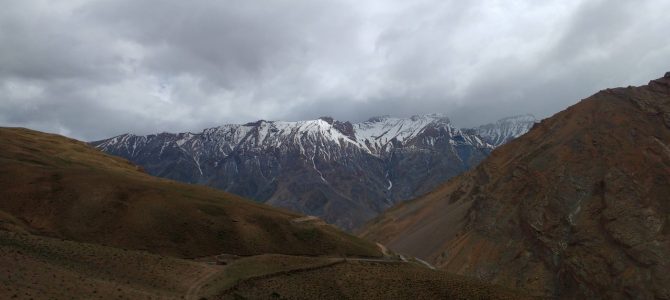Previously little known, Spiti district of Himachal Pradesh has gained popularity among backpackers during the last few years. This is because Spiti has some unique places. After all who can resist a place that has the world’s highest post office, the world’s oldest continuously running Buddhist monastery and an embalmed mummy of a Buddhist monk?
Geography of Spiti
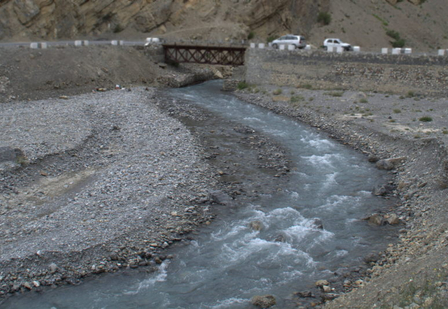
Spiti river flowing outside Kaza town.
Spiti district is tucked away in the north-eastern corner of India in Himachal Pradesh. Lahaul, Kullu and Spiti districts flank the north, west and east of Spiti district respectively. The entire eastern boundary of Spiti district is the international boundary with Tibet. While Kullu and Kinnaur regions are green with plenty of trees and forests, Spiti region looks like a desert. In fact, Spiti looks exactly like Jammu-Kashmir’s Ladakh region. Spiti is in the high-altitude zone (above 3,000 metres / 10,000 feet) and does not have dense vegetation. But the region is not short of water. The Spiti river with its several tributaries forms an ample water source for this region.
People of Spiti
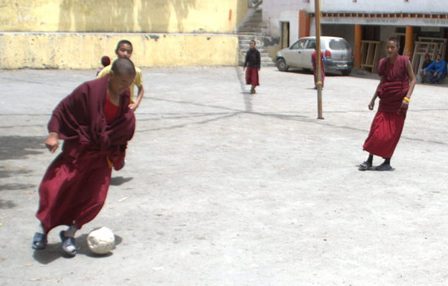
Monks playing football at the Key monastery.
Spiti follows a culture that is totally different from the rest of Hinduism / Sikhism following and Pahadi-speaking Himachal Pradesh. In fact, Spiti is culturally closer to Tibet. The people follow Buddhism and natively speak a language called Spitian, which is a modified form of Tibetan. The script for the language is the same as the Tibetan script. Similar to J&K’s Ladakh, Spitians also use the greeting ‘Jullay’. Despite the terrain not supporting major agriculture, Spitians have found a way to cultivate crops that do not require a perennially moist soil. The Spiti river and its system of tributaries, have made tracts of land where the soil is reasonably fertile and can support the growth of millets, corn, peas and Spiti’s own form of oranges and apples. Animal rearing and dairy are also major occupations. Cottage industries exist in the form of wool knitting and handicrafts.
Lately, Tourism has catching up in Spiti and several people are setting up part of their homes as rooms for guests. However, professionalism is yet to set in and you will come across people trying to rip you off with exorbitant rates. This is peculiar considering that the rest of Himachal Pradesh is professional, not extremely money-minded and is not associated with people who rip off.
Here is the list of places to see in Spiti region.
Kaza
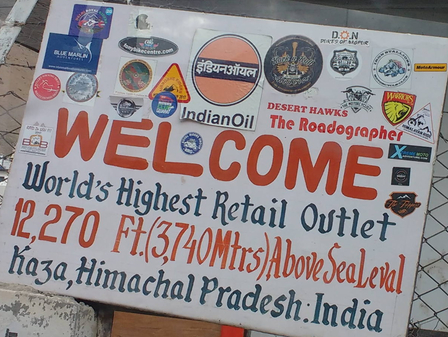
A board for the world’s highest petrol pump. Subsequently, several motorbike groups have stuck their own biking company logos on that board in an act of hubris.
Kaza is the principal city of Spiti district. It is the town with the world’s highest petrol pump operated by Indian Oil. Kaza is not a tourist destination, but is a transport hub for visiting other areas in Spiti. Right outside the petrol pump is a line of 8 stupas, each representing one phase of Buddha’s life. Across the road from the stupas is the Kaza monastery, which was inaugurated by His Holiness, Dalai Lama the 14th.
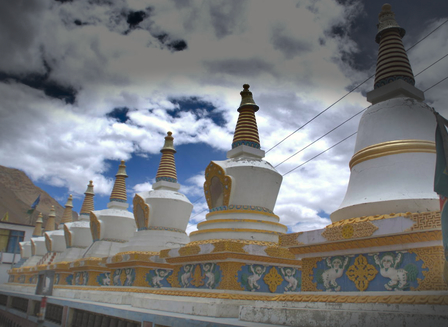
The 8 stupas at Kaza
Key monastry
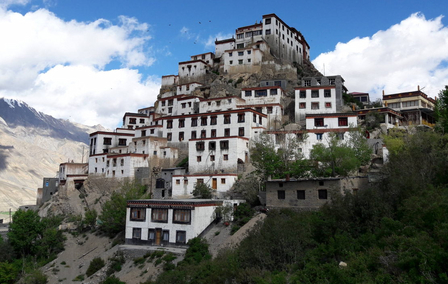
One of the best views of the multi-level Key monastery.
Situated 16 km from Kaza, Key monastry is an old monastry built in the 11th century. It is in the village of Key. In Key monastery, one can spend the night at one of the rooms at the monastic quarters. The layout of the monastery is really beautiful as one can see a cluster of buildings, i.e. monastic quarters, offices and prayer rooms, forming a pyramidal structure as rooms were added over time on the slope of the mountain. While breakfast, lunch and dinner are served at specific times of the day, we discovered a more fascinating experience. In the morning, you can join the monks as they offer their morning prayers. After prayer, they are served a very modest breakfast. If you are in the prayer chambers, they serve you the same breakfast that they serve the monks. It consists of a flour made of various millets and is mixed with milk. The two are mixed together and consumed as a dough. It is neither tasty, nor interesting. But it fills you up incredibly. The flour is very rich and when combined with milk, the meal is really heavy. We found out that this can keep monks going all day or until their next meal. The prayer room at the summit of the monastery is for adult monks. There is a seperate room for child monks in a chamber downstairs and they follow a similar ritual.
Hikkim
At 4,400 metres or 14,440 feet, Hikkim has the world’s highest post office. For fun, one can try posting a letter back home from this post office. Such an experience shows how reliable Indian Postal service can be.
Langza
The Himalayas were formed due to tectonic plates colliding with each other. The plates ran into each other and starting rising above the sea bed. Today, it is the sedimentary rocks of the sea beds that stand at dizzying altitudes of 3,000+ metres or 10,000+ feet. This is hard to imagine, but proof of this can be seen in the Spitian village of Langza. Strewn over the landscape around the village are fossils of sea molluscs that lived 50 million years ago. Trapped into the sedimentary rocks of barren Spiti, the bones are still in remarkable condition and plentiful in number.
Tabo
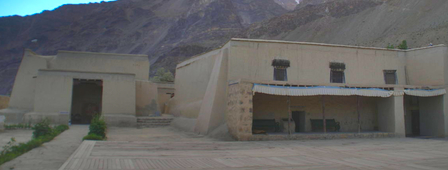
The ancient Tabo monastery complex, which is the longest continuously functioning monastery in the world.
The world’s oldest continuously functioning Buddhist monastery is in the Spitian village of Tabo. The monastery was started in 996 AD and has never ceased to function. That makes it 1023 years of service, and counting, on the day I write this. The old monastery is made of limestone and clay. Inside the monastery are several murals, which are claimed by the locals to have appeared overnight. Near the old monastery, a new monastery, consecrated by His Holiness, Dalai Lama the 14th, stands today. Adjacent to the monastery are monk quarters and an attached guest house. Travellers can stay at this guest house.
Giu
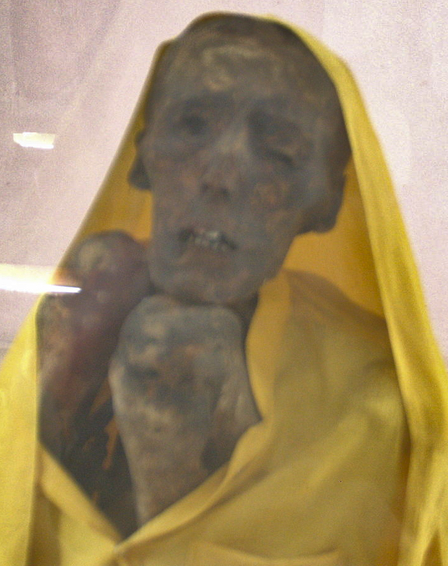
The 500-year old mummy of a Buddhist monk at the temple of Giu.
On the highway that leads from Tabo to Kinnaur via Sumdo, a small road spurs off at a confluence where a smaller river joins the Spiti river. 8 km uphill is the village of Giu, where a Buddhist monk was mummified more than 500 years ago. The Spiti people used to terminate their dead by throwing them to vultures or feeding them to fish. That a monk was mummified in this culture is a surprise. But the story has been lost and all we have today is a glass case with a dried body with distinct facial features, teeth and eye sockets.
Getting around Spiti
There is very limited public transport in Spiti. Most villages are connected to Kaza by one bus every day in each direction. The buses are subject to cancellation due to weather conditions, breakdowns or landslides. If you miss a bus or if the bus decides not to run that day, then there is nothing you can do, but alter your plans for the day. Taxis are horribly exorbitant and you need to pool a group of 5-6 people to get a reasonable shared rate. Another option is to hitchhike.
With such non-guaranteed transport conditions, it is virtually impossible to make an advance day-by-day itinerary in Spiti. Plans should be made roughly and you should be ready to go back to your hotel / lodge room if the conditions are against you. The only guaranteed itinerary is if you bring your own car or motorbike. If you don’t have one, you can hire one at New Delhi, Shimla or Manali. During peak season, even rented bikes are horribly expensive, such that the cost of a 5-day Spiti itinerary will shoot to 5 figure numbers, excluding petrol and maintenance.

Public transport is sparse in Spiti and you will often end up walking either half-way or all the way to your destination. The only guaranteed ways to get around are exorbitant taxis or your own vehicle.
During India 360, we followed a combination of buses and hitch-hiking, with no guaranteed plans. We skipped two of the above places because buses were not available, taxis were too expensive and no one else was there to share a ride with us. Now given a choice, we will repeat the trip by taking our motorbike by train from Mumbai to Chandigarh and then riding one of the following routes: Shimla – Manali – Spiti or Shimla – Kinnaur – Spiti.
What to eat
Spiti’s food follows two cultures. First, we get Pahadi food like the rest of Himachal, i.e. Paratha, Chapati, daal rice, vegetables and milk products. But then, there is food that resembles Tibetan food. Home-baked millet bread, porridge, etc. Non-vegetarian people can try lamb, chicken and fresh trout from Spiti river. While at Key monastery, you should eat during the monks’ breakfast. We already described the experience under the heading ‘Key monastery’ above.
Conclusion
Spiti region is a completely different experience to the rest of India. Their life still seems to be set in the 17th century. The society is still agrarian and cattle-rearing. The modern facilities of Internet, rapid transport, 8-lane asphalt / concrete roads, world cuisines and 5-star hotels still seem at least a decade away. However, that helps you be present and appreciate the simpler pleasures of life, such as walking through a cool breeze, looking at snow-capped mountains, enjoying the soft, rhythmic sound of a rapid flowing Spiti river and greeting complete strangers, who greet you back with a broad, warm smile capable of melting the snow and with a sing-song tune in their voice as they say, ‘Jullay’!

